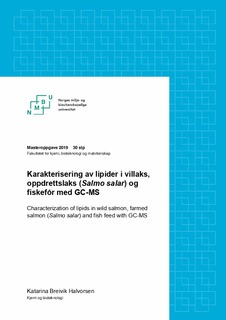| dc.contributor.advisor | Ekeberg, Dag | |
| dc.contributor.advisor | Devle, Hanne | |
| dc.contributor.author | Halvorsen, Katarina Breivik | |
| dc.date.accessioned | 2019-08-14T12:39:00Z | |
| dc.date.available | 2019-08-14T12:39:00Z | |
| dc.date.issued | 2019 | |
| dc.identifier.uri | http://hdl.handle.net/11250/2608316 | |
| dc.description.abstract | Hovedmålet med dette studiet var å sammenlikne fettsyresammensetningen i villaks og oppdrettslaks (Salmo salar). Dette sees i sammenheng med ernæringsmessige forskjeller ved inntak av disse to produktene. Vi ønsket å finne total fettsyreprofil i villaks, oppdrettslaks og fiskefôr, samt å fraksjonere lipidene i ulike lipidklasser. Fisk er for mange en viktig kilde til å få i seg viktige n-3 fettsyrer. Fiskefôret har fått mer vegetabilske ingredienser enn før. Dette har ført til økt mengde vegetabilske n-6 fettsyrer og mindre av de viktige marine n-3 fettsyrene i oppdrettslaks. Det var derfor interessant å se konsentrasjonsforskjeller av viktige n-3 fettsyrer i villaks og oppdrettslaks, og se hvor mye fôret påvirker fettsyrene i oppdrettslaksen.
Fettsyrene ble funnet ved hjelp av en gasskromatograf koblet sammen med et tre-sektor massespektrometer. Metoden for ekstraksjon og derivatisering av lipidene var allerede etablert og inkluderte ekstraksjon med Folchs løsning, samt derivatisering til fettsyremetylestere. Fettsyrene i villaks og oppdrettslaks ble også fraksjonert med en SPE-robot for å dele lipidene inn i nøytrale lipider, frie fettsyrer og polare lipider. Forskjeller i mengden av n-3- og n-6 fettsyrer, samt mettede fettsyrer (SFA), enumettede fettsyrer (MUFA) og flerumettede fettsyrer (PUFA) er tatt med i diskusjonen for å se på villaks og oppdrettslaks fra et helsemessig perspektiv.
Det var stor forskjell i fettinnholdet i laksen. Oppdrettslaksen (13,2%) var mye fetere enn villaksen (1,8%). Oppdrettslaksen hadde derfor også en høyere konsentrasjon av de fleste fettsyrer, der C18:1cis9 utgjorde hele 50% av fettsyrene i laksen. Oppdrettslaks inneholdt mer n-3 fettsyrer, men også betydelig mer n-6 fettsyrer i forhold til villaks. Både oppdrettslaks og villaks inneholdt relativt små mengder polare lipider og frie fettsyrer, men villaks hadde betydelig mer frie fettsyrer enn oppdrettslaks. Villaks og oppdrettslaks inneholdt mer MUFA og PUFA i forhold til SFA. Både villaks og oppdrettslaks inneholdt omtrent lik mengde av de to viktige marine n-3 fettsyrene eikosapentaensyre (EPA) og dokosaheksaensyre (DHA), men villaks hadde det mest gunstige n-6/n-3 forholdet. Oppdrettslaks og fiskefôr inneholdt de samme fettsyrene og forholdet mellom fettsyrene var også relativt lik. | nb_NO |
| dc.description.abstract | The main objective of this study was to compare the fatty acid composition of wild and farmed salmon (Salmo salar). This was seen in the context of nutritional differences in the use of these two products. We wanted to determine the total fatty acid profile in wild salmon, farmed salmon and fish feed, as well as to fractionate the lipids into different lipid classes. Fish is for many people an important source of the crucial n-3 fatty acids. The fish feed consists of more vegetable ingredients than before. This has led to an increase of vegetable n-6 fatty acids and less of the important marine n-3 fatty acids in farmed salmon. Therefore, it was interesting to see differences in concentration levels of n-3 fatty acids in wild and farmed salmon, and to see how much the feed affects the fatty acid profile in the farmed salmon.
The fatty acids were found by using a gas chromatograph coupled with a three-sector mass spectrometer. The method for extraction and derivatization of the lipids was previously established and included solvent extraction and derivatization into fatty acid methyl esters. The fatty acids in wild and farmed salmon where also fractionated with an SPE robot to divide the lipids into neutral lipids, free fatty acids and polar lipids. Differences in the quantity of n-3 fatty acids, n-6 fatty acids, as well as saturated fatty acids (SFA), monounsaturated fatty acids (MUFA) and polyunsaturated fatty acids (PUFA) are included in the discussion to look at wild and farmed salmon from a health perspective sight.
There was a big difference in fat content in salmon. The farmed salmon had a significantly higher fat content (13,2%) compared to the wild salmon (1,8%). The farmed salmon had therefore also a higher concentration of most fatty acids, where C18:1cis9 amounted 50% of the fatty acids in the salmon. The farmed salmon contained more n-3 fatty acids, but also significantly more n-6 fatty acids than the wild salmon. Both farmed and wild salmon contained relatively small amounts of polar lipids and free fatty acids, but the wild salmon had considerably more free fatty acids than the farmed salmon. Wild and farmed salmon contained more MUFA and PUFA compared to SFA. Both wild and farmed salmon contain approximately equal amounts of the two major marine n-3 fatty acids eicosapentaenoic acid (EPA) and docosahexaenoic acid (DHA), but wild salmon had the most favourable n-6/n-3 ratio. Farmed salmon and fish feed contained the same fatty acids and the ratio of the fatty acids was also relatively similar. | nb_NO |
| dc.language.iso | nob | nb_NO |
| dc.publisher | Norwegian University of Life Sciences, Ås | nb_NO |
| dc.rights | Attribution-NonCommercial-NoDerivatives 4.0 Internasjonal | * |
| dc.rights.uri | http://creativecommons.org/licenses/by-nc-nd/4.0/deed.no | * |
| dc.subject | Organisk kjemi | nb_NO |
| dc.subject | Fish food | nb_NO |
| dc.title | Karakterisering av lipider i villaks, oppdrettslaks (Salmo salar) og fiskefôr med GC-MS | nb_NO |
| dc.title.alternative | Characterization of lipids in wild salmon, farmed salmon (Salmo salar) and fish feed with GC-MS | nb_NO |
| dc.type | Master thesis | nb_NO |
| dc.source.pagenumber | 78 | nb_NO |
| dc.description.localcode | M-KB | nb_NO |

